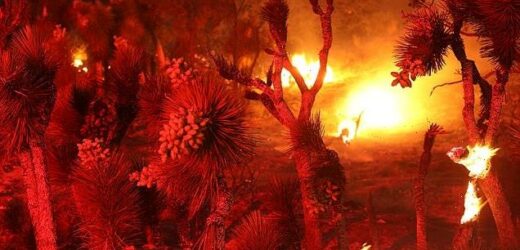Wildfires may have sparked Earth’s largest mass extinction event, new research reveals
- The Permian mass extinction, which took place about 248 million years ago, may have been caused in part by widespread wildfires
- ‘The potential for wildfires as a direct extinction driver during hyperthermal events, rather than a symptom of climatic changes deserves further examination,’ researchers say
- Scientists examined fossil and plant charcoal records of the Sydney and Bowen basins in eastern Australia and Antarctica in order to gain new insights
Researchers believe the Permian mass extinction event 248 million years ago that killed off almost every species on Earth may have been sparked in part by widespread wildfires.
Greenhouse gas emissions from volcanos, higher temperatures and dry landscapes led to wildfires in areas that were previously wetlands.
Since the wetlands were no longer capturing carbon from the atmosphere, that in turn led to more warming.
Scientists studied fossil plant record to gain a better understanding of what drove the Permian extinction event. Pictured above is the Sheep Fire burning through a forest on a hillside in Wrightwood, California
‘Sifting through the fossil plant records of eastern Australia and Antarctica, we found high abundances of burnt, or charcoalified, plants throughout the late Permian Period,’ says Chris Mays, lecturer in paleontology at University College Cork (UCC) and lead author of the study.
‘From this high baseline, charcoal abundances reached a prominent peak right at the top of the last Permian coal beds, indicating a major but short-lived increase in wildfires. This was followed by low charcoal for the next three million years of the Early Triassic Period,’ Mays further explains in a statement.
A warming climate and increased fire activity during the extinction event seems to have pushed all the plants to the breaking point. Pictured above is a forest fire raging in the Kyrenia mountains in the Turkish Republic of Northern Cyprus
Researchers noted that regions of carbon capture are necessary to fight climate change, otherwise the world could ‘stay intolerably warm for hundreds of millennia.’ Pictured above is a firefighter working to put out a fire in Laguna Niguel, California
Fossil and plant charcoal records of the Sydney and Bowen basins in eastern Australia and Antarctica provided researchers with the information that the wetlands were being disrupted by regular wildfires.
Plants at the time evolved a range of ways to deal with ever-present fires.
Even so, the researchers note that the warming climate and increased fire activity during the extinction event seems to have pushed all the plants, including the ones that tried to adapt, to the breaking point.
The Permian mass extinction event is also known as the Great Dying. Pictured above is a house on fire from the Zogg Fire near Ono, California
It took millions of years for the planet’s eco-system to recover after that extinction event.
All life on Earth today is descended from the roughly 10 percent of animals, plants and microbes that somehow survived the Permian mass extinction.
It’s believed that a massive volcanic eruption released chemicals removed the Earth’s ozone layer and exposed all living organisms to the sun’s powerful radiation.
The researchers also note that wildfires in the modern era have also led to massive die-offs of animals all over the world.
Our own warming climate has led to longer and more frequent draughts and more wildfires in areas that were typically wet, the researchers note, including the peat forests of Indonesia.
WHAT WAS THE PERMIAN MASS EXTINCTION, KNOWN AS ‘THE GREAT DYING’ THAT KILLED 9 OUT OF EVERY 10 SPECIES?
Around 248 million years ago, the Permian period ended and the Triassic period started on Earth.
Marking the boundary between these two geologic eras is the Permian mass extinction, nicknamed ‘The Great Dying’.
This catastrophic event saw almost all life on Earth wiped out.
Scientists believe around 95 per cent of all marine life perished during the mass extinction, and less than a third of life on land survived the event.
In total, it is believed that 90 per cent of all life was wiped out.
All life on Earth today is descended from the roughly ten per cent of animals, plants and microbes that survived the Permian mass extinction.
Previously, it was believed a huge eruption blanketed the Earth in thick smog, blocking the sun’s rays from reaching the planet’s surface.
However, new findings suggest a massive volcanic eruption that ran for almost one million years released a huge reservoir of deadly chemicals into the atmosphere that stripped Earth of its ozone layer.
This eradicated the only protection Earth’s inhabitants had against the sun’s deadly UV rays.
This high-energy form of radiation can cause significant damage to living organisms, causing the death toll to skyrocket.
Environmentalist have noted that areas of natural carbon capture from the atmosphere are a big part of mitigating the impact of climate change.
Scientists in the study say that without these regions of carbon capture, the world could ‘stay intolerably warm for hundreds of millennia.’
‘The potential for wildfires as a direct extinction driver during hyperthermal events, rather than a symptom of climatic changes deserves further examination.
‘Unlike the species that suffered the mass extinctions of the past, we have the opportunity to prevent the burning of the world’s carbon sinks and help avoid the worst effects of modern warming,’ says Mays.
The research was published in the journal Palaios.
Source: Read Full Article






